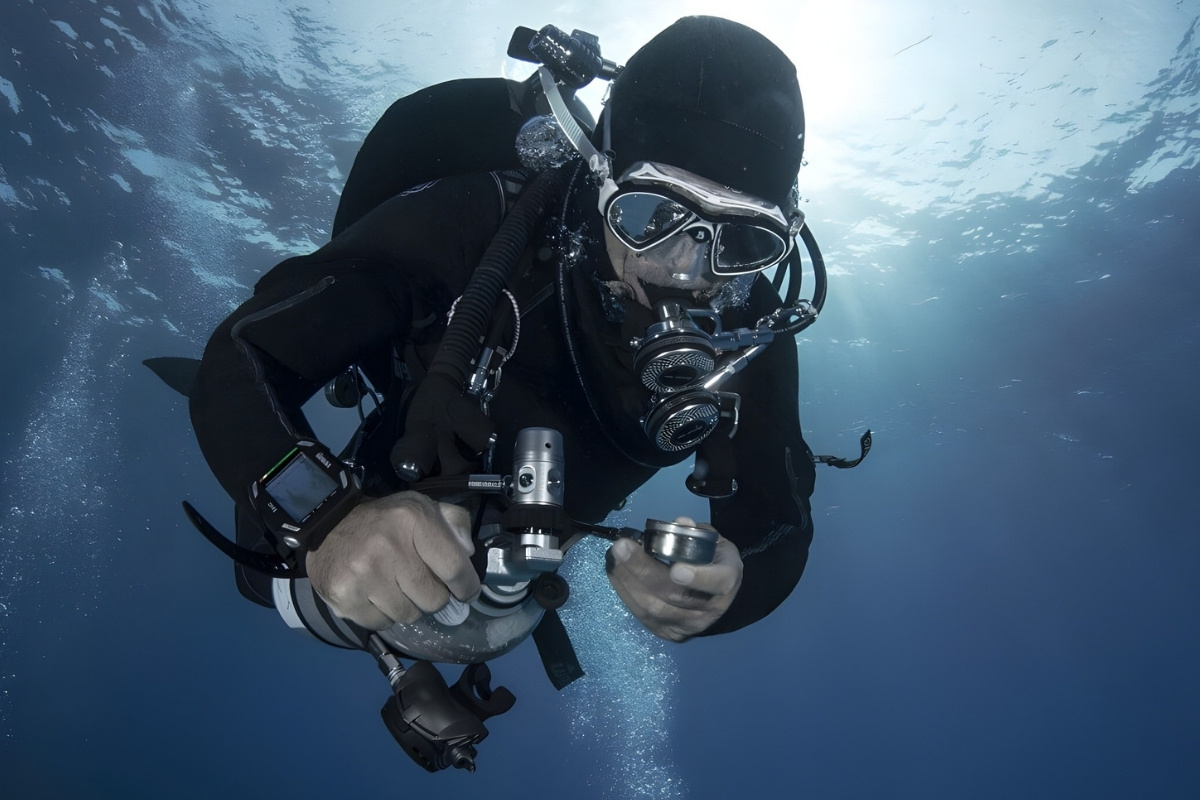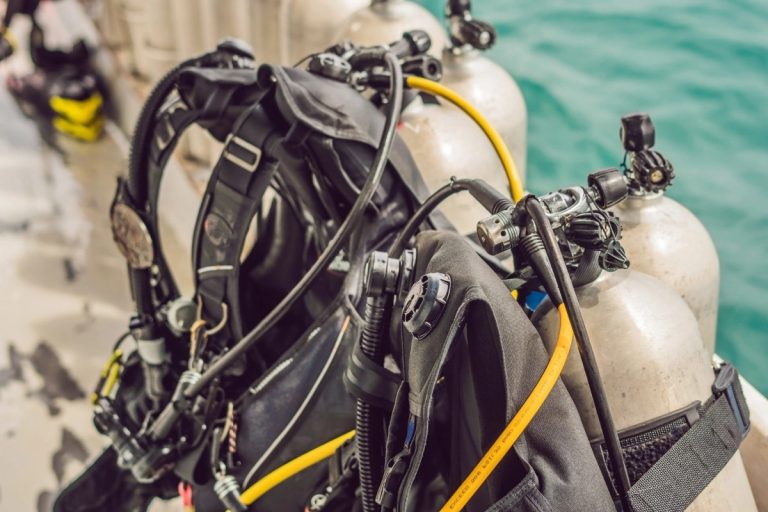Understanding Air Integration
Air integration represents one of the most significant technological advances in modern dive computers. This sophisticated feature transforms how divers monitor their air supply, offering real-time data that enhances both safety and dive planning capabilities.
When examining the features of air integration, you’ll find that this technology connects wirelessly to your tank’s first stage regulator through a transmitter. This connection provides continuous monitoring of your remaining air supply, displayed directly on your dive computer’s screen. The system calculates not just your current tank pressure, but also your consumption rate and estimated remaining dive time based on your current breathing patterns.
The integration goes beyond simple pressure readings. Advanced systems can track multiple tanks simultaneously, making them invaluable for technical divers using different gas mixtures. Some models even provide alerts when your air consumption rate increases significantly, which might indicate stress or increased exertion underwater.
What is Air Integration?
Air integration technology uses wireless transmitters attached to your regulator’s high-pressure port to communicate tank pressure data to your dive computer. These transmitters operate on radio frequencies specifically designed for underwater use, typically around 123 kHz, ensuring reliable communication even at significant depths.
The system works by measuring the pressure in your tank and transmitting this information to your dive computer several times per minute. This constant communication allows the computer to calculate not just your current air supply, but also predict how long your air will last based on your consumption patterns.
Benefits of Air Integration
The primary advantage of air integration lies in its ability to provide comprehensive air management without requiring you to check a separate pressure gauge. This streamlined approach reduces the number of instruments you need to monitor during a dive, allowing you to focus more on your surroundings and dive experience.
Air integration also enables advanced calculations that manual pressure checks cannot provide. Your dive computer can calculate your surface air consumption rate, predict remaining dive time, and even adjust decompression calculations based on your actual air supply rather than theoretical dive profiles.
How Air Integration Works
The wireless transmitter screws directly into your regulator’s high-pressure port, replacing or supplementing your traditional pressure gauge. Once activated, it begins broadcasting your tank pressure to your paired dive computer. The computer receives this data and processes it alongside depth, time, and temperature information to provide comprehensive dive metrics.
Modern systems use sophisticated algorithms to filter out interference and ensure accurate readings. The transmitters are designed to be robust and reliable, with battery life typically lasting 200-300 dives depending on usage patterns and environmental conditions.
Compatibility with Dive Computers
Not all dive computers support air integration, and compatibility varies between manufacturers. Most air integration systems use proprietary protocols, meaning transmitters from one brand typically won’t work with computers from another manufacturer. This compatibility requirement is important to consider when upgrading or replacing equipment.
Some manufacturers offer retrofit options for older dive computer models, while others require you to purchase a complete new system. Before investing in air integration, verify that your current dive computer supports this feature or factor the cost of a compatible computer into your budget.
Common Issues with Air Integration
While air integration technology is generally reliable, divers occasionally experience connectivity issues, particularly in environments with high electromagnetic interference. Metal structures, other electronic devices, or even certain types of dive equipment can sometimes interfere with the wireless signal between transmitter and computer.
Battery management becomes more critical with air integration systems, as both the transmitter and dive computer require power. Transmitter batteries typically last longer than dive computer batteries, but planning for replacement and carrying spares becomes essential for extended dive trips or technical diving operations.
Exploring the Digital Compass
Digital compasses have revolutionized underwater navigation, offering precision and convenience that traditional magnetic compasses struggle to match. These electronic navigation tools integrate seamlessly with modern dive computers, providing real-time directional information that enhances dive safety and exploration capabilities.
Unlike traditional compasses that rely on magnetic needles, digital compasses use electronic sensors to detect magnetic fields and calculate bearing information. This technology eliminates many of the mechanical limitations associated with traditional compasses, such as needle sticking or bubble formation that can affect accuracy.
The integration of digital compasses into dive computers creates a comprehensive navigation system that can store waypoints, track your dive path, and even guide you back to specific locations. This capability proves invaluable for wreck diving, cave diving, or any situation where precise navigation is critical for safety.
What is a Digital Compass?
A digital compass uses electronic magnetometers to detect the Earth’s magnetic field and calculate directional bearings. These sensors convert magnetic field strength into digital signals that the dive computer’s processor can interpret and display as compass headings, typically shown in degrees from magnetic north.
The digital format allows for enhanced features like bearing memory, where you can lock in a specific direction and receive guidance to maintain that heading. Many systems also provide reciprocal bearings automatically, helping you navigate back along the same path you used to reach your current location.
Uses of Digital Compass in Diving
Digital compasses serve multiple purposes during diving activities. Navigation represents the primary use, helping divers maintain proper heading during limited visibility conditions or when following specific dive plans. The compass becomes essential for boat diving, where returning to the anchor line requires precise navigation.
Search and recovery operations benefit significantly from digital compass capabilities. Divers can establish search patterns, mark specific locations, and navigate systematically across search areas. The ability to store multiple waypoints allows for complex search operations that would be difficult to execute with traditional navigation methods.
Comparison with Traditional Compasses
Traditional magnetic compasses offer simplicity and reliability without requiring battery power, making them appealing for backup navigation. However, digital compasses provide superior accuracy and additional features that enhance their utility for modern diving applications.
Digital systems eliminate the air bubble problems that can affect traditional compasses at depth. They also provide more precise readings and can compensate for local magnetic variations that might affect traditional compass accuracy in certain geographic areas.
Limitations of Digital Compasses
Digital compasses require battery power and can be affected by electronic interference from other devices. Metal objects, electrical equipment, or even certain types of dive gear can influence their accuracy. Understanding these limitations helps divers use digital compasses effectively while maintaining backup navigation methods.
Calibration requirements represent another consideration for digital compass users. These systems typically require periodic calibration to maintain accuracy, and the calibration process can be more complex than simply checking a traditional compass for proper operation.
User Reviews and Feedback
Diver feedback on digital compass systems generally emphasizes their convenience and accuracy advantages over traditional alternatives. Users appreciate the integration with dive computer displays and the ability to access compass information without manipulating separate instruments during dives.
Some users report initial learning curves when transitioning from traditional compasses, particularly regarding calibration procedures and understanding the various display options. However, most divers adapt quickly and find the enhanced features valuable for their diving activities.
Diving Apps Overview
Mobile applications have transformed how divers plan, log, and analyze their underwater adventures. These digital tools offer capabilities that extend far beyond traditional paper logbooks, providing comprehensive dive management systems that integrate with modern dive computers and online communities.
The evolution of diving apps reflects broader technological trends in mobile computing and cloud storage. Modern apps can sync dive data across multiple devices, share experiences with diving communities, and provide access to extensive databases of dive sites, marine life, and safety information.
Integration capabilities represent a key strength of contemporary diving apps. Many can connect directly with dive computers to download dive profiles, eliminating manual data entry and ensuring accurate record keeping. This connectivity also enables advanced analytics that help divers understand their diving patterns and improve their skills.
Popular Diving Apps
Several diving apps have gained widespread adoption among the diving community. Subsurface stands out as a comprehensive, open-source dive logging application that supports numerous dive computer brands and provides detailed analytics. The app’s cross-platform compatibility makes it accessible to divers using various devices and operating systems.
MacDive offers Mac users a polished diving application with excellent integration capabilities and intuitive interface design. The app supports automatic dive computer downloads and provides sophisticated dive planning tools that appeal to both recreational and technical divers.
Features of Diving Apps
Modern diving apps typically include digital logbook functionality, dive planning tools, and equipment tracking capabilities. The digital logbook replaces traditional paper records with searchable, backup-protected databases that can include photos, videos, and detailed dive site information.
Dive planning features help divers calculate air consumption, plan decompression stops, and analyze dive profiles before entering the water. These tools prove particularly valuable for technical divers planning complex multi-level or decompression dives that require precise timing and gas management.
How to Choose the Right App
Selecting the appropriate diving app depends on your specific needs and diving style. Recreational divers might prioritize ease of use and social sharing features, while technical divers may require advanced planning tools and support for multiple gas mixtures.
Compatibility with your dive computer represents a crucial consideration. Verify that your chosen app can connect with your specific dive computer model and download data in the formats you need. Some apps support only certain manufacturers or require additional hardware for connectivity.
User Experience with Diving Apps
User feedback on diving apps generally emphasizes the convenience of digital record keeping and the ability to access dive information from anywhere. Divers appreciate the backup security that cloud storage provides, protecting years of dive logs from loss or damage.
Some users report challenges with app complexity, particularly when transitioning from simple paper logbooks to feature-rich digital alternatives. The learning curve varies depending on the app’s design and the user’s technical comfort level, but most divers find the benefits outweigh the initial adjustment period.
Future Trends in Diving Apps
The future of diving apps likely includes enhanced artificial intelligence features that can analyze diving patterns and provide personalized recommendations for improvement. Machine learning algorithms might identify potential safety issues or suggest optimal dive profiles based on individual diving history.
Augmented reality integration represents another potential development, with apps possibly providing underwater navigation assistance or marine life identification through waterproof device housings. These advanced features could transform how divers interact with their underwater environment.
Safety Features in Dive Computers
Modern dive computers incorporate sophisticated safety features designed to prevent decompression sickness and other diving-related injuries. Understanding these safety systems and learning how to read your dive computer effectively ensures you can make informed decisions throughout your dive.
Contemporary safety features go beyond basic decompression calculations to include comprehensive monitoring systems that track multiple risk factors simultaneously. These systems analyze your dive profile, breathing gas mixtures, and physiological factors to provide real-time safety guidance and warnings.
The integration of multiple safety systems creates redundant protection layers that help prevent accidents even when individual components fail or when divers make errors in judgment. This comprehensive approach to safety represents one of the most significant advances in diving technology over the past decade.
Essential Safety Features
Decompression algorithms form the foundation of dive computer safety systems, calculating nitrogen absorption and elimination based on established mathematical models. Modern computers often allow users to choose between different algorithms or adjust conservatism factors to match their personal risk tolerance and diving conditions.
Ascent rate monitoring prevents divers from ascending too quickly, which can cause decompression sickness or arterial gas embolism. Most computers provide both audible and visual warnings when ascent rates exceed safe limits, typically around 30 feet per minute for recreational diving.
Understanding Alerts and Notifications
Dive computers use various alert systems to communicate important safety information during dives. Visual displays typically include flashing warnings, color changes, or special symbols that indicate specific conditions requiring attention. Understanding these visual cues helps divers respond appropriately to changing conditions.
Audible alerts provide additional warning capabilities, particularly useful in low visibility conditions where visual displays might be difficult to read. Different alert patterns typically indicate different types of warnings, from simple reminders to critical safety alerts requiring immediate action.
Importance of Regular Updates
Firmware updates for dive computers often include safety improvements, bug fixes, and enhanced algorithm accuracy. Manufacturers regularly release updates based on field experience and ongoing research into decompression physiology, making regular updates important for maintaining optimal safety performance.
Some updates address specific safety issues discovered through user feedback or incident analysis. Staying current with manufacturer recommendations ensures your dive computer provides the most accurate and reliable safety information available.
Battery Management for Safety
Battery failure during a dive can eliminate critical safety information and decompression guidance. Most modern dive computers provide low battery warnings well in advance of complete failure, but understanding your computer’s power consumption patterns helps prevent unexpected shutdowns.
Backup power systems or user-replaceable batteries provide additional safety margins for extended diving operations. Some technical divers carry backup dive computers specifically to address potential battery failures during complex dives requiring precise decompression management.
Dive Planning Tools
Integrated dive planning features help divers prepare safe dive profiles before entering the water. These tools can calculate optimal bottom times, required surface intervals, and gas consumption requirements based on planned depth and duration parameters.
Advanced planning tools support technical diving operations with multiple gas mixtures, complex decompression schedules, and contingency planning for emergency situations. These features prove invaluable for divers planning challenging dives that require precise timing and resource management.
Comparing Different Models
The dive computer market offers numerous options ranging from basic recreational models to sophisticated technical diving instruments. Understanding the differences between wrist-mounted vs. console options helps divers select equipment that matches their diving style, experience level, and budget requirements.
Console-mounted computers integrate with traditional gauge setups, providing familiar instrument layouts for divers transitioning from analog gauges. These systems often include additional instruments like depth gauges, compasses, and pressure gauges in a single console unit.
Wrist-mounted computers offer convenience and accessibility, allowing divers to check information easily throughout the dive without manipulating console equipment. The wrist-mounted format also provides better protection for the computer during entries, exits, and navigation through tight spaces.
Wrist-Mounted Dive Computers
Wrist-mounted dive computers provide excellent accessibility and protection during diving operations. The wrist location allows for easy viewing without requiring hand movements that might disturb buoyancy or positioning, particularly important during photography or delicate marine life observations.
Modern wrist computers often include additional features like fitness tracking, GPS capabilities, and smartphone connectivity that extend their utility beyond diving applications. This versatility appeals to divers who prefer multi-purpose devices that serve various recreational and professional needs.
Console Dive Computers
Console-mounted computers integrate seamlessly with traditional scuba equipment configurations, providing a familiar instrument layout that many experienced divers prefer. The console format allows for larger displays and additional instruments that might be difficult to incorporate into wrist-mounted designs.
The protected location within the console system provides excellent protection from impact damage during equipment handling and transportation. Console computers also typically offer longer battery life due to their larger size and reduced power consumption requirements compared to feature-rich wrist models.
Pros and Cons of Each Model
Wrist-mounted computers excel in accessibility and convenience but may be more susceptible to damage during equipment handling or accidental impacts. The smaller display size can also limit the amount of information displayed simultaneously, requiring menu navigation to access all available data.
Console computers provide larger displays and better protection but require more deliberate actions to check during dives. The console location can also make the computer more difficult to read in certain diving positions or when wearing thick gloves in cold water conditions.
Cost Comparison
Entry-level wrist computers typically cost less than comparable console systems due to their simpler construction and fewer integrated components. However, high-end wrist computers with advanced features can exceed the cost of basic console systems significantly.
Console systems often provide better value for divers who need multiple instruments, as integrated consoles cost less than purchasing separate components. The total cost of ownership should include consideration of battery replacement, maintenance, and potential upgrade paths for both system types.
User Preferences and Trends
Current market trends show increasing preference for wrist-mounted computers, particularly among younger divers and those who value multi-purpose functionality. The integration of fitness tracking, GPS, and smartphone connectivity appeals to divers who want devices that serve multiple purposes.
Experienced technical divers often prefer console systems for their larger displays and ability to integrate multiple specialized instruments. The choice frequently depends on diving style, with recreational divers favoring wrist units and technical divers preferring console configurations.
Maintenance of Dive Computers
Proper maintenance ensures dive computers provide accurate, reliable performance throughout their service life. Following established dive computer maintenance tips helps prevent failures that could compromise safety or result in expensive repairs or replacements.
Regular maintenance involves both routine care procedures that divers can perform themselves and periodic professional services that address internal components and calibration requirements. Understanding which tasks you can handle and when to seek professional assistance helps maintain optimal computer performance.
Environmental factors significantly impact dive computer longevity and reliability. Saltwater exposure, temperature extremes, and physical impacts all affect electronic components and sealing systems. Proper care procedures address these environmental challenges and extend equipment service life.
Routine Maintenance Tasks
Post-dive rinsing with fresh water removes salt deposits and contaminants that can damage seals and electronic components over time. Thorough rinsing should include all external surfaces, paying particular attention to button areas and display surfaces where salt buildup commonly occurs.
Periodic inspection of sealing surfaces and battery compartments helps identify potential problems before they cause failures. Look for signs of corrosion, seal damage, or moisture intrusion that might indicate the need for professional service or component replacement.
Battery Replacement Guide
Battery replacement procedures vary significantly between dive computer models, with some requiring special tools or techniques to maintain waterproof integrity. Always consult manufacturer instructions before attempting battery replacement, as improper procedures can damage sealing systems.
User-replaceable battery systems typically include clear instructions and require only basic tools, but maintaining proper seal installation remains critical. Professional battery replacement services ensure proper sealing and often include pressure testing to verify waterproof integrity after service.
Troubleshooting Common Issues
Display problems, connectivity issues, and erratic behavior often result from simple causes that divers can address without professional service. Low battery power, incorrect settings, or software glitches account for many reported dive computer problems.
Systematic troubleshooting approaches help identify the root cause of problems and determine whether professional service is necessary. Many issues resolve through simple procedures like factory resets, battery replacement, or software updates that users can perform independently.
Cleaning and Care Tips
Proper cleaning techniques remove contaminants without damaging sensitive components or display surfaces. Use only manufacturer-approved cleaning products and avoid abrasive materials that might scratch displays or damage protective coatings.
Storage conditions significantly impact dive computer longevity, particularly for units with rechargeable batteries. Store computers in cool, dry environments and maintain appropriate charge levels to prevent battery degradation during extended storage periods.
When to Seek Professional Help
Complex internal problems, calibration issues, and physical damage typically require professional service capabilities. Attempting repairs beyond your skill level can cause additional damage and may void warranty coverage.
Pressure testing after any service work ensures continued waterproof performance and safety. Professional service centers have specialized equipment to verify proper sealing and calibration that individual divers cannot replicate with standard tools.
Entry-Level Dive Computers
New divers benefit significantly from starting with appropriate entry-level equipment that provides essential features without overwhelming complexity. Understanding the landscape of top entry-level dive computers helps beginners make informed decisions that support their diving development and safety.
Entry-level computers focus on core functionality while maintaining user-friendly interfaces that don’t intimidate new divers. These devices typically include essential decompression calculations, safety features, and basic dive logging capabilities without the advanced features that technical divers require.
The transition from basic dive tables to electronic dive computers represents a significant safety improvement for new divers. Computers provide real-time decompression information and safety monitoring that helps prevent the calculation errors that can occur with manual dive planning methods.
Features to Look For
Essential features for entry-level dive computers include reliable decompression algorithms, clear displays, and intuitive user interfaces. New divers benefit from computers that provide clear, easy-to-understand information without requiring extensive menu navigation during dives.
Safety features like ascent rate warnings, safety stop timers, and low battery alerts provide crucial protection for inexperienced divers who may not yet recognize potential problems independently. These automated safety systems help prevent common beginner mistakes that could lead to injury.
Top Brands in Entry-Level Models
Several manufacturers specialize in entry-level dive computers that balance affordability with reliability. These companies focus on providing essential features while maintaining competitive pricing that appeals to budget-conscious new divers.
Established diving equipment manufacturers often offer simplified versions of their advanced computers, providing proven technology in more accessible packages. These entry-level models typically use the same basic algorithms and safety systems as their premium counterparts.
User Recommendations
Experienced divers frequently recommend specific entry-level models based on their reliability, ease of use, and manufacturer support quality. User reviews and recommendations provide valuable insights into real-world performance and common issues that specifications alone cannot reveal.
Diving instructors often have extensive experience with various entry-level computers through their students and can provide practical advice about which models work best for new divers. Their recommendations typically emphasize reliability and simplicity over advanced features.
Price Range Analysis
Entry-level dive computers typically range from basic models under $200 to more feature-rich options approaching $400. The price difference usually reflects display quality, additional features, and build quality rather than fundamental safety capabilities.
Budget considerations should include long-term costs like battery replacement, potential upgrades, and compatibility with future equipment purchases. Sometimes spending slightly more initially provides better long-term value through improved durability and upgrade paths.
Reviews and Ratings
User reviews provide valuable insights into real-world performance, reliability, and customer service experiences that help inform purchasing decisions. Pay attention to reviews from divers with similar experience levels and diving styles to your own situation.
Professional reviews from diving publications and equipment testing organizations offer technical analysis and comparative evaluations that complement user feedback. These sources often provide detailed testing results and expert opinions about performance and value.
Customization Options
Modern dive computers offer extensive customization capabilities that allow divers to tailor their instruments to match personal preferences and diving styles. These customization options enhance usability and ensure that critical information remains easily accessible during dives.
Personalization extends beyond simple preference settings to include safety parameters, display configurations, and alert systems that can be adjusted to match individual risk tolerance and diving experience levels. This flexibility helps divers optimize their computers for specific diving environments and activities.
The ability to customize dive computers becomes particularly important as divers gain experience and develop specific preferences for information display and alert systems. Advanced customization options allow experienced divers to fine-tune their computers for optimal performance in various diving scenarios.
Adjusting Settings for Personal Use
Display customization options typically include screen brightness, contrast, and information layout preferences that help optimize visibility in various lighting conditions. Some computers allow users to choose which information appears on primary displays and which requires menu access.
Algorithm settings enable divers to adjust conservatism factors and select different decompression models based on their personal risk tolerance and diving conditions. These adjustments help match computer calculations to individual physiological factors and diving experience levels.
Custom Alerts and Notifications
Personalized alert systems allow divers to set specific warnings for depth limits, bottom time restrictions, and safety parameters that match their diving plans and experience levels. Custom alerts help ensure that important information receives appropriate attention during dives.
Alert timing and intensity settings enable divers to balance safety awareness with dive enjoyment, preventing excessive warnings that might distract from the diving experience while maintaining appropriate safety monitoring.
User Interface Personalization
Menu organization and navigation preferences help divers optimize their computers for quick access to frequently used functions. Customizable interfaces reduce the time required to access important information during dives, improving both safety and convenience.
Display themes and color schemes allow divers to select visual presentations that work best for their vision and diving conditions. High-contrast options prove particularly valuable for divers with vision challenges or those diving in low-light environments.
Syncing with Other Devices
Connectivity options enable dive computers to share data with smartphones, tablets, and computers for comprehensive dive logging and analysis. This integration creates seamless workflows that eliminate manual data entry and ensure accurate record keeping.
Cloud synchronization capabilities provide automatic backup protection for dive logs and settings, preventing data loss and enabling access from multiple devices. These features prove particularly valuable for frequent travelers who access their dive information from various locations.
Future Customization Features
Emerging customization capabilities include artificial intelligence systems that learn individual diving patterns and automatically adjust settings for optimal performance. These adaptive systems could eventually provide personalized recommendations based on diving history and preferences.
Integration with wearable fitness devices and health monitoring systems may enable dive computers to incorporate physiological data into their calculations and recommendations. This integration could provide more personalized safety guidance based on individual health and fitness levels.
Frequently Asked Questions
What is air integration in dive computers?
Air integration is a feature that allows dive computers to wirelessly receive real-time data about a diver’s air supply from a transmitter attached to the tank’s regulator.
How does a digital compass work in diving?
Digital compasses use electronic sensors to detect magnetic fields and calculate directional bearings, providing accurate navigation information without mechanical limitations.
What are some benefits of using diving apps?
Diving apps offer features like digital logbooks, dive planning tools, and the ability to sync data across devices, enhancing the overall diving experience.
How important is regular maintenance for dive computers?
Regular maintenance is crucial to ensure dive computers operate reliably and safely, preventing potential failures that could compromise diver safety.
What should I consider when choosing a dive computer?
Consider factors such as compatibility with air integration systems, safety features, ease of use, and whether the model suits your diving style and experience level.
Embracing the Future of Diving Technology
As technology continues to advance, embracing the latest features in dive computers can significantly enhance safety, navigation, and overall diving experiences. Divers should stay informed about these innovations to make educated choices that align with their diving needs.






